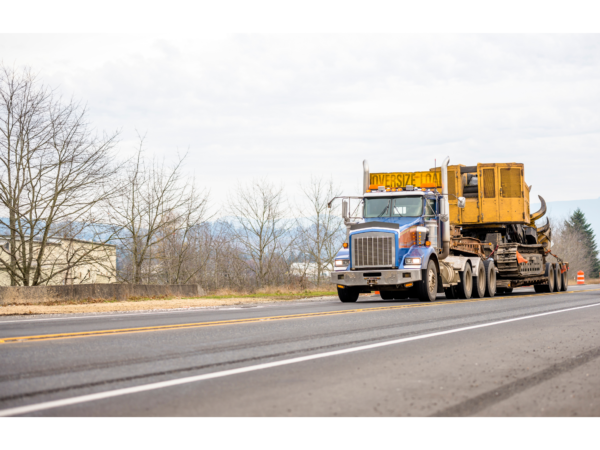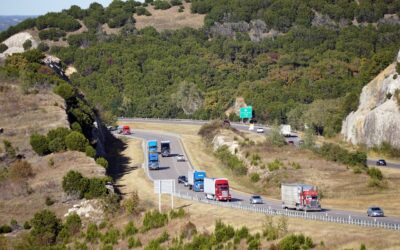Wide Loads vs. Oversized Loads: Knowing the Difference
Heavy equipment, such as construction equipment and agricultural machinery, comes in a variety of different shapes and sizes. When it comes to hauling heavy equipment, the size and weight of the machinery matter. Oversized construction machines, such as excavators and backhoes, are particularly large and difficult to transport without the right gear. Agricultural equipment is also considered oversized and requires special considerations for transportation.
What Is a Wide Load?
Wide loads in Ontario are considered to be loads that are wider than 3.70 m on two-lane highways and 3.85 m on multi-lane highways. The specific legal dimensions vary depending on the province but generally range between 3 m to 3.7 m.
Wide loads are shipments that exceed the width restriction, but the rest of their dimensions can vary. They may fit within the regulated height, length, and weight categories, or they may go over. If they are over the limit in other dimensions, there are additional rules that need to be followed in addition to the wide load regulations. While referred to as a wide load, it is also considered an oversized load.
What Is An Oversized Load?
Oversized and overweight loads are classified as loads that exceed the maximum height, maximum length, maximum width or maximum weight limits. When any of these limits of width, height, length or weight are breached, the driver must obtain permits to travel on public highways across North America. Examples of oversized loads in construction include cranes, dump trucks, bulldozers, and sometimes excavators. Other industrial equipment, such as wind turbines, are often transported on public roads in multiple loads for each piece and are still considered oversized loads due to their excessive sizes.
Why Are There Special Requirements For Oversized Loads?
Oversized permits are necessary for two main reasons:
To Protect the Public
Transporting oversized equipment can be particularly hazardous to other drivers who share the same public roads. For example, a wide load that infringes on two lanes of traffic can disrupt regular traffic flow. In order to protect the public, heavy haul drivers will be required to follow several rules in order to move safely and alert the public of any oncoming hazard.
To Preserve Public Infrastructure
Wide, tall, and heavy loads can present a potential risk to road infrastructure. Tall and wide loads can damage tunnels and overpasses; heavy loads can affect the integrity of older bridges and even damage roadways. For this reason, drivers carrying oversized loads must follow provincial regulations, which may include taking alternate routes when potential hazards exist.
Special Requirements for Oversized Loads
In order to transport oversized loads across Canada and the United States, there are several factors to consider.
Apply For Permits
Each province across Canada has specific requirements for shipping oversized equipment, so you must comply with all of their rules and apply for the proper permits. For example, in Ontario, loads that are greater than 5 m in width, 45.75 m in length and/or over 120,000 kg in weight require a superload permit. Permits such as these take longer to organize, so you must prepare well ahead of time.
Type of Trailer
The type of trailer that is needed to transport your equipment depends on the weight and the dimensions of your machinery. Removable gooseneck trailers are ideal for overweight machinery due to the ability to have extra axles to accommodate higher weights. Their low-bed truck beds can also be used to accommodate taller pieces of equipment, making it a highly versatile trailer.
Follow Securement Rules
Federal and Provincial transportation authorities have clearly defined securement rules for normal and oversized loads. This includes the type of chains and straps that must be used and the grade of chain needed to secure the weight. A driver is also required to test the securement system before setting off and periodically check for movement and tighten straps along the way. This is especially important when preparing a shipment for a long haul.
Permitted Travel Times
Many provinces apply travel restrictions on when oversized loads can be transported on public roadways. Travel may be limited on public holidays and during peak times on weekdays. Many provinces also forbid travel due to unfavourable atmospheric conditions. Fog poses a serious hazard to heavy haul drivers and surrounding vehicles due to poor visibility.
Display the Proper Signage
Both wide and oversized loads are required to display extra signage, lights and flags to alert surrounding drivers of their presence. Again, signage requirements vary by province, so check regulations prior to travel, as failure to display the correct signage will result in heavy fines.
Hire Escort Vehicles
Certain overweight permits require you to hire pilot cars to escort the oversized load for the duration of the trip. The pilot car driver and heavy haul driver stay in close contact during the trip. The driver in the pilot car can alert oncoming traffic of the heavy load approaching. In addition, they can also alert the heavy haul driver of any problems that may impede travel.
Professional Heavy Hauling Services for Oversized Equipment
Between gathering the proper permits and correctly securing your heavy machinery, a professional heavy hauler has the skill and the experience to deliver your machinery safely to its destination. Our drivers are also cargo insured, so from the time your equipment is picked up to the time it is delivered to its destination, you can have peace of mind knowing that everything is covered.
Secure Your Next Oversized Delivery Anywhere Across North America
At Trusted Dispatch, our Expert Drivers can deliver your heavy equipment anywhere in North America. Secure your next delivery by getting your instant free quote now!





